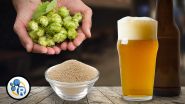(Press-News.org) URBANA - University of Illinois scientists have engineered a "jailbreaking" yeast that could greatly increase the health benefits of wine while reducing the toxic byproducts that cause your morning-after headache.
"Fermented foods--such as beer, wine, and bread--are made with polyploid strains of yeast, which means they contain multiple copies of genes in the genome. Until now, it's been very difficult to do genetic engineering in polyploid strains because if you altered a gene in one copy of the genome, an unaltered copy would correct the one that had been changed," said Yong-Su Jin, a U of I associate professor of microbial genomics and principal investigator in the Energy Biosciences Institute.
Recently scientists have developed a "genome knife" that cuts across multiple copies of a target gene in the genome very precisely--until all copies are cut. Jin's group has now used this enzyme, RNA-guided Cas9 nuclease, to do precise metabolic engineering of polyploid Saccharomyces cerevisiae strains that have been widely used in the wine, beer, and fermentation industries.
The possibilities for improved nutritive value in foods are staggering, he said. "Wine, for instance, contains the healthful component resveratrol. With engineered yeast, we could increase the amount of resveratrol in a variety of wine by 10 times or more. But we could also add metabolic pathways to introduce bioactive compounds from other foods, such as ginseng, into the wine yeast. Or we could put resveratrol-producing pathways into yeast strains used for beer, kefir, cheese, kimchee, or pickles--any food that uses yeast fermentation in its production."
Another benefit is that winemakers can clone the enzyme to enhance malolactic fermentation, a secondary fermentation process that makes wine smooth. Improper malolactic fermentation generates the toxic byproducts that may cause hangover symptoms, he said.
Jin stressed the genome knife's importance as a tool that allows genetic engineers to make these extremely precise mutations.
"Scientists need to create designed mutations to determine the function of specific genes," he explained. "Say we have a yeast that produces a wine with great flavor and we want to know why. We delete one gene, then another, until the distinctive flavor is gone, and we know we've isolated the gene responsible for that characteristic."
The new technology also makes genetically modified organisms less objectionable, he said. "In the past, scientists have had to use antibiotic markers to indicate the spot of genetic alteration in an organism, and many persons objected to their use in foods because of the danger of developing antibiotic resistance. With the genome knife, we can cut the genome very precisely and efficiently so we don't have to use antibiotic markers to confirm a genetic event."
INFORMATION:
The research was reported in a recent issue of Applied and Environmental Microbiology.
Co-authors of "Construction of a Quadruple Auxotrophic Mutant of an Industrial Polyploid Saccharomyces cerevisiae Strain by Using RNA-Guided Cas9 Nuclease" are Guochang Zhang, In Iok Kong, Heejin Kim, Jingjing Liu, and Yong-Su Jin, of the University of Illinois at Urbana-Champaign, and Jamie H.D. Cate of the University of California, Berkeley, and Lawrence Berkeley National Laboratory. The research was funded by the Energy Biosciences Institute.
The Energy Biosciences Institute is a public-private collaboration in which bioscience and biological techniques are being applied to help solve the global energy challenge. The partnership, funded with $500 million for 10 years from the energy company BP, includes researchers from UC Berkeley; the University of Illinois, and the Lawrence Berkeley National Laboratory. The research was conducted in the Energy Biosciences Institute, a public-private collaboration funded by the energy company BP. The EBI includes researchers from UC Berkeley, the University of Illinois, and the Lawrence Berkeley National Laboratory. Details about the EBI can be found on the website: http://www.energybiosciencesinstitute.org .
NEW YORK, March 16, 2015 - Newer drug-coated stents that keep arteries open have similar long-term rates of death compared with traditional bypass surgery for patients with more than one diseased coronary artery.
The findings come from a clinical registry study, led by cardiologists at NYU Langone Medical Center, which appears in this week's issue of the New England Journal of Medicine.
In the study, a sample of over 9,000 patients who received the latest stents were no more likely to die in the few years following the procedure, compared to a matched sample of over ...
SAN DIEGO (March 16, 2015) -- Among patients with heart failure and atrial fibrillation, those who underwent catheter ablation were less likely to die, be hospitalized or have recurrent atrial fibrillation than patients taking a heart rhythm regulating drug, according to a study presented at the American College of Cardiology's 64th Annual Scientific Session.
Catheter ablation was most successful in procedures where ablation was required in other areas in addition to the pulmonary vein, researchers said.
Heart failure and atrial fibrillation often co-occur and are two ...
SAN DIEGO (March 16, 2015) -- Patients with atrial fibrillation who received ablation while they were already undergoing surgery to correct a leaky heart valve had fewer episodes of atrial fibrillation a year later compared to patients who had the valve surgery alone, according to a study presented at the American College of Cardiology's 64th Annual Scientific Session.
The patients who received ablation along with mitral valve surgery had no more deaths, adverse cardiac events or hospitalizations than patients who only received the valve surgery alone, but they were ...
SAN DIEGO (March 16, 2015) -- Patients who underwent a simple conditioning procedure involving the inflation and deflation of a blood pressure cuff on the upper arm before coronary artery bypass grafting, known as heart bypass surgery, had no better long-term health outcomes than bypass patients who did not receive the conditioning, according to research presented at the American College of Cardiology's 64th Annual Scientific Session in San Diego.
The study, the first large randomized controlled trial to investigate the effectiveness of remote ischemic preconditioning ...
Researchers have identified a new host of gene variants that could make people vulnerable to sporadic motor neurone disease, according to a report published today in the journal, Scientific Reports.
Until recently, it was thought that genetics made little contribution to the disease - also termed amyotrophic lateral sclerosis (ALS) - and that the environment was mostly to blame.
Currently two to three thousand Australians are living with this fatal disease. Motor neurone disease (MND) is a group of diseases in which the nerve cells in the brain and spinal cord controlling ...
BEER-SHEVA, Israel...March 15, 2015 - Ben-Gurion University of the Negev (BGU) researchers have developed a groundbreaking approach to determine sleep quality using their new breath sound analysis (BSA). This is less expensive and invasive than current polysomnography (PSG) technology, according to a new study published on PLOS Online.
"One of the main goals of sleep medicine today is to improve early diagnosis and treatment of
the 'flood" of subjects presenting with sleep disorders," says Prof. Yaniv Zigel Ph.D., head of the Biomedical Signal Processing Research Lab ...
Research shows that depictions of race on television news programs can strongly influence support for police among non-white viewers. The study was conducted by researchers at North Carolina State University, the University of Utah, Indiana University and the University of California, Los Angeles.
"Black men and women - particularly black men - are over-represented as criminals or criminal suspects on TV news, and under-represented as law enforcement or authority figures, and as victims of crime," says Dr. Ryan Hurley, an assistant professor of communication at NC State ...
This news release is available in German.
Leipzig/Berlin. A public and scientific discussion is currently taking place focusing on the question whether substances at low concentrations may lead to health impairments in humans. For this reason, an increasing number of experimental studies to test such effects are currently conducted using different chemicals. It was possible to demonstrate, for example, that even low quantities of benzo[a]pyrene can have effects on the protein pattern and hence the metabolism and signal pathways in cells, even though the concentration ...
WASHINGTON, March 16, 2015 -- It's been around for centuries but it seems like beer has never been more popular. Microbreweries are cranking out special stouts, IPAs, lagers and pilsners. And the flavors and aromas of each of those brews all come down to chemistry. This week, in honor of St. Patrick's Day, Reactions takes on craft beer chemistry. Sip on the video here: https://youtu.be/vW99JEaDApY.
INFORMATION:Subscribe to the series at http://bit.ly/ACSReactions, and follow us on Twitter @ACSreactions to be the first to see our latest videos.
The American Chemical ...
Cells have two different programs to safeguard them from getting out of control and developing cancer. One of them is senescence (biological aging). It puts cancer cells into a permanent sleep so they no longer divide and grow in an uncontrolled way. Now the research group led by Professor Walter Birchmeier (Max Delbrück Center for Molecular Medicine, MDC, Berlin-Buch) has discovered that an enzyme known to be active in breast cancer and leukemia blocks this protection program and boosts tumor growth. They succeeded in blocking this enzyme in mice with breast cancer, ...


